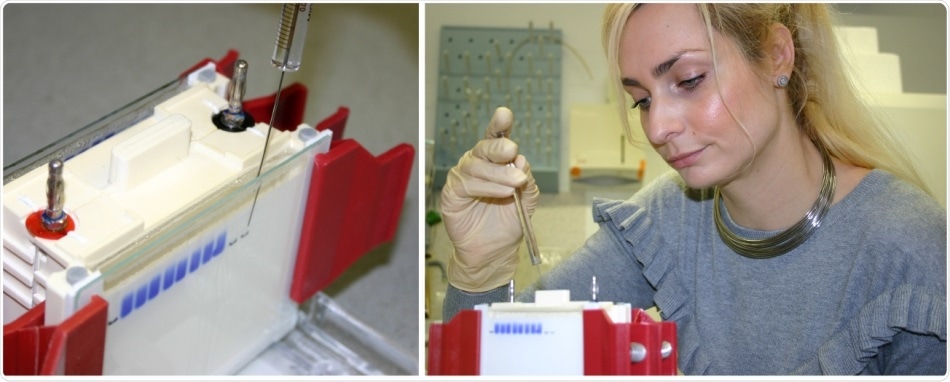During the process of each single cell division, the chromosomal genetic data should be uniformly distributed between the freshly developing daughter cells.

Susanne Hellmuth MSc, PhD, student at the Chair of Genetics at the University of Bayreuth, here loading samples for the separation of proteins and their subsequent immunological detection. Image Credit: Olaf Stemmann.
Separase is an enzyme that significantly contributes to this cell division process. Now, Susanne Hellmuth and Olaf Stemmann from the Chair of genetics at the University of Bayreuth discovered a previously unknown mechanism that controls the activity of the enzyme separase.
Such important discoveries add a new dimension to the present interpretation of chromosome inheritance. The researchers have described their work in the Nature journal.
Crucial for healthy cell development: the regulation of separase
Cell division is crucial for the growth and reproduction of humans. Before a cell starts to divide, the genetic data preserved on the chromosomes are replicated.
Once this process is over, each chromosome will contain two identical threads of DNA called the sister chromatids. Cohesin—a ring containing many proteins—encapsulates each chromosome and keeps the pair of sister chromatids together.
During preparation for cell division, cohesin is already removed from the chromosomal arms. But the whole separation of the sister chromatids can occur only when the cohesin left in the center of the chromosomes is divided by the separase enzyme.
The sister chromatids subsequently move to the two reverse ends of the spindle apparatus, in which they form the genetic groundwork for the developing daughter cells.
The presence of genetic defects in the daughter cells can disrupt their healthy development. Hence, to meet this condition, the enzyme separase should become active just at the right time. In case the sister chromatids are divided prematurely, they can only be distributed haphazardly.
The daughter cells, thus obtained, would then contain the incorrect chromosome number and eventually die, or they can turn into cancer cells. These genetic malfunctions can be prevented only through rigorous regulation of the enzyme separase.
A “guardian spirit” suppresses premature sister chromatid separation
The scientists Susanne Hellmuth and Olaf Stemmann from the University of Bayreuth, in association with geneticists from Spain-based University of Salamanca, have recently found that the same regulating function is exhibited by the protein shugoshin (a Japanese term that stands for “guardian spirit”). This protein causes the separase enzyme to stay inactive until the right time arrives for cohesion.
Armed with this latest finding, the researchers have successfully solved a crucial mystery of genetics: To date, only the securin protein was known to inhibit the separase’s premature activity. Hence, it was assumed that this protein solely regulates the separase enzyme.
But this observation challenged the view that the separase enzyme continues to be suitably mediated even in the absence of securin.
Currently published in the Nature journal, the study provides an explanation on this contradiction: Both securing and shugoshin proteins inhibit the separase enzyme from triggering the chromosomal segregation process at the wrong time. But if the securin protein fails, the shugoshin protein can singularly control the activity of the separase enzyme in human cells.
We are dealing with a type of redundancy that is not at all uncommon in the cell cycle: In order for a vital process to proceed in a well-ordered manner, nature has safeguarded it by controlling it simultaneously in two or more different ways. This makes the process particularly robust, but also difficult to study, because individual disturbances have no visible effect.”
Susanne Hellmuth, Study First Author and Researcher, University of Bayreuth
Dual control through the spindle checkpoint
Hellmuth and Stemmann have definitely made an additional discovery: The spindle assembly checkpoint (SAC) plays a major role in regulating the impact of both securin and shugoshin proteins.
This discovery proves the well-established belief in the study that the SAC has, as it were, governs all the processes implicated in chromosome inheritance.
The SAC was already known to initially stabilize the securing protein and does not promote its degradation until the time has arrived for cohesin splitting by the separase enzyme.
The Nature publication currently demonstrates how the checkpoint causes the shugoshin protein to inhibit the premature activity of the separase enzyme, such as by associating the shugoshin protein with the SAC component Mad2.
I was particularly pleased to hear a remark on our publication by one referee that the textbooks will now have to be rewritten. Our further research will show how our fundamental findings could also find their way into cancer therapy.”
Olaf Stemmann, Chair of Genetics, University of Bayreuth
Source:
Journal reference:
Hellmuth, S., et al. (2020) Securin-independent regulation of separase by checkpoint-induced shugoshin–MAD2. Nature. doi.org/10.1038/s41586-020-2182-3.